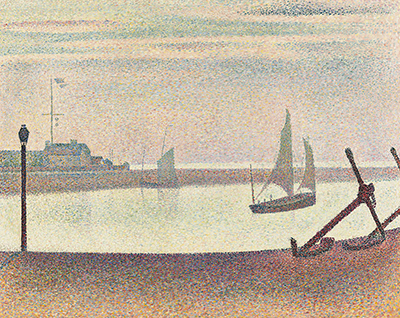A few years before his death that occurred in March 1981, George-Pierre Seurat took time to produce about 20 paintings. In 1890, while in Gravelines, a town located on the Northern side of the French Coast, Seurat made four pieces of artwork. Among those paintings is “The Channel at Gravelines, Evening”. The artwork is oil on canvas, measuring 25 by 32 inches. It is currently on display in New York, at the Museum of Modern Art. (MOMA)
Painting this piece of art, Seurat not only wanted the viewers drawn into the painting through reality but also the involvement of their emotions. The Channel at Gravelines Evening, therefore, adopted a Post-Impressionist style. Seurat also wanted this painting to illuminate the brilliance of colour by applying tiny strokes of colour that beautifully blended. He not only applied pointillism when painting this impressive piece of art, but also divisionism.
Under the sunrise, the shore is quite visible. The tides have already gone and what is left is the expansive beach that can be seen on the foreground. There are also signs to signal for shallow waters that are not suitable for boat riding. Along the beachfront, there are some houses lined up. There are barely any people in the entire setup.
Seurat has used the blue stripe cutting horizontally through the canvas to divide the painting into two parts. The two short posts seem to be connecting both the two parts. The goal is to create some illusion of depth and avoid the scene looking too fixed. This has been achieved by slightly elevating the horizontal axis. The post on the extreme right brings in more attention to the painting.
A white diagonal line cuts across the beach. It is parallel to the triangular part that is covered in green grass and located along the dunes. The inclusion of the posts, the grass and the line of houses show how vital observation was to Seurat.
Two colours largely dominate the painting. The beach’s pale yellow/cream and the light blue colour is coming from the sky. Paying close attention to detail reveals that the canvas is covered in dots and strokes of paint that produce an illuminated effect. There is no uniformity in the strokes depicted, and they range from tiny to broad.
To create a change between the real frame and the picture, Seurat has created a border painted of tiny coloured dots. Each part of the border is coloured in a way that it complements the area next to it by making the colour more visible. For instance, the indigo on the frame’s bottom suits the yellow sand on the beach.
In this artwork, the scene depicted portrays credibility, and the view depicted is stunning. The details of the painting are presented in a straightforward, yet unique and intriguing way. The observations of the entire painting are simply stunning.




